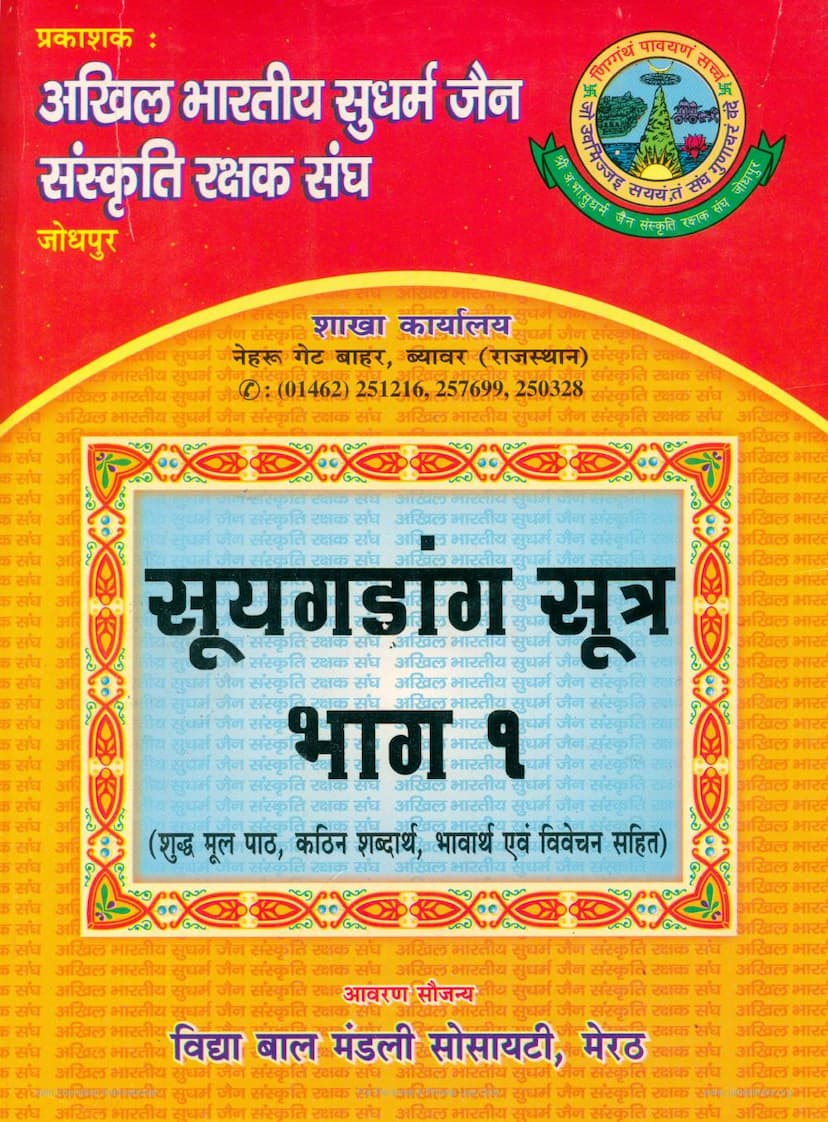Suyagadanga Sutra Part 01
Added to library: September 2, 2025

Summary
Here is a comprehensive summary of the provided Jain text, "Suyagadanga Sutra Part 01," based on the given pages:
This text is the first part of the Suyagadanga Sutra, a significant Jain scripture. The publication is by Akhil Bharatiya Sudharm Jain Sanskruti Rakshak Sangh, Jodhpur. The book is presented as the 89th gem in their literature series, compiled and translated by Nemichand Banthiya and Parasmal Chandaliya. It aims to provide the pure original text with difficult word meanings, commentary, and analysis.
Key Themes and Content:
The introductory sections (preface and early pages) of the book establish the importance of Jain literature, particularly the Agamas, as the repository of the teachings of the Tirthankaras. It highlights the unique clarity, depth, and comprehensive nature of Jain philosophy, emphasizing the omniscience of the Tirthankaras and the detailed exposition of various spiritual states, karmic principles, and celestial realms.
The text then proceeds to introduce the Suyagadanga Sutra, positioning it as the second Anga Sutra in the Jain canon, following the Achara-anga Sutra. While Achara-anga focuses on the conduct of ascetics, Suyagadanga delves into philosophical understanding and refutation of other religious views, presenting a beautiful synthesis of conduct (Achar) and philosophy (Vichar).
The summary then provides an overview of the sixteen studies (Adhyayanas) within the first Skandha of the Suyagadanga Sutra, with a brief description of each:
- Samaya (Self and Others' Doctrines): Discusses gaining enlightenment, understanding the nature of bondage, refuting other philosophical views, and establishing the Jain doctrine of non-violence, control of passions, etc.
- Vaitaliya (Destruction of Karma): Focuses on the destruction of karma and the root causes of karma like attachment, aversion, and delusion. It emphasizes detachment and overcoming ignorance.
- Upsarga Parigjna (Understanding Afflictions): Deals with enduring hardships and adversies during spiritual practice, emphasizing steadfastness in the face of challenges.
- Stri Parigjna (Understanding Women/Desires): Addresses the dangers of attachment to women and worldly desires, cautioning ascetics to remain vigilant to protect their spiritual path.
- Naraka Vibhaga (Division of Hell): Explains the consequences of sinful actions like violence, falsehood, theft, etc., and details the nature of hellish realms and the suffering experienced there.
- Virasthuti (Praise of the Hero): Presents the praise of Lord Mahavir's virtues and qualities as narrated by Lord Sudharma to Jambu Swami, who had not personally seen Lord Mahavir.
- Kushila Paribhasha (Definition of the Corrupt): Differentiates between virtuous and corrupt ascetics, defining the latter as those who indulge in flawed practices or foods, deviating from the path of restraint.
- Virya (Energy/Potency): Discusses the concept of spiritual energy (Bhava Virya) and its types: Pandit Virya (excellent), Bal Pandit Virya (moderate), and Bal Virya (inferior). It encourages striving for 'Akarm Virya' (actionless virtue).
- Dharma (Righteousness): Elucidates the nature of true Dharma as understood through right faith, knowledge, and conduct, as propounded by the Vitaragas (the Tirthankaras). It stresses the need to renounce attachment to worldly possessions and worldly life for the sake of liberation.
- Samadhi (Concentration/Equanimity): Explains the nature of mental concentration and equanimity achieved through pure practice of knowledge, faith, conduct, and penance. It guides in overcoming mental afflictions and external disturbances.
- Moksha Marga (Path to Liberation): Outlines two paths: the auspicious (Pashasta) and the inauspicious (Aprashasta). The path of right faith, knowledge, and conduct is the auspicious path leading to liberation.
- Samavasarana (Religious Assembly): Discusses the assembly of Tirthankaras, outlining 363 different philosophical viewpoints prevalent at that time (Kriyavadi, Akriyavadi, Ajnanavadi, Vinayavadi) and refutes them to establish the supremacy of the Jain path.
- Yathathathya (Reality/Truth): This study focuses on presenting true principles, detailing the practices of virtuous ascetics that lead to liberation and the reasons for the wandering of the wicked ascetics in the cycle of birth and death.
- Grantha (Bondage): Explains the concept of bondage, both external (material possessions) and internal (anger, pride, deceit, greed), and the path to freedom from these bonds.
- Adaniya (Acceptance/Rejection): Discusses the principles of acceptance and rejection, distinguishing between proper and improper acceptance or rejection in terms of actions and motivations.
- Gatha (Verse/Praise): This study consolidates the virtues of ascetics described in the previous fifteen studies, presenting a comprehensive praise of their conduct and qualities.
The text further details the initial verses (Gathas) of the first study, 'Samaya,' which begins with an invocation and then discusses the eternal nature of Jainism and the Tirthankaras. It outlines the twelve Angas of the Jain canon. The initial verses focus on the concept of bondage, the 'Veer' (Tirthankara Mahavir), and how to break free from the cycle of karma. It also begins to critique various philosophical schools of thought prevalent during that time.
The provided pages detail the introductory material and the beginning of the first chapter of the first Skandha, setting the stage for the profound philosophical and ethical teachings contained within the Suyagadanga Sutra. The text emphasizes the importance of right knowledge and conduct for achieving liberation and systematically refutes heterodox views to establish the Jain perspective.